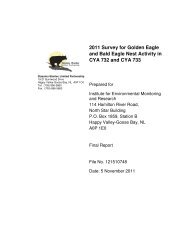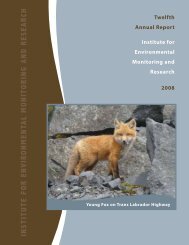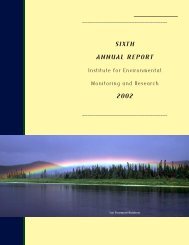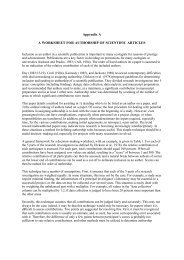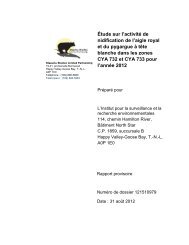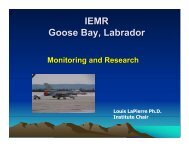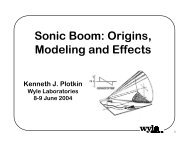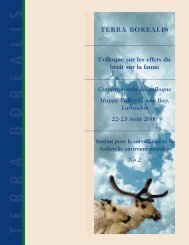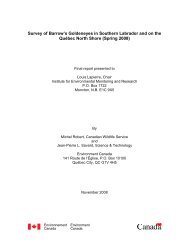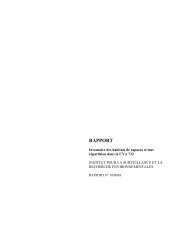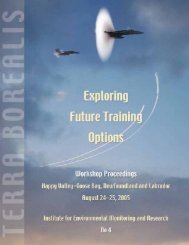2007 Annual Report - Institute for Environmental Monitoring and ...
2007 Annual Report - Institute for Environmental Monitoring and ...
2007 Annual Report - Institute for Environmental Monitoring and ...
- No tags were found...
Create successful ePaper yourself
Turn your PDF publications into a flip-book with our unique Google optimized e-Paper software.
<strong>Environmental</strong><strong>Monitoring</strong> <strong>and</strong> ResearchWOODLAND CARIBOUWoodl<strong>and</strong> caribou in Labrador <strong>and</strong> Quebec are listedas threatened under the SARA. This includes the RedWine Mountains Caribou Herd, the Lac JosephCaribou Herd, <strong>and</strong> caribou found in the Joir Riverarea of southern Labrador. The SRC have identifiedissues of concern with the distribution of woodl<strong>and</strong>caribou in the southern boundaries of the trainingarea associated with training block CYA 733.In <strong>2007</strong> under a service agreement with the <strong>Institute</strong>,the Wildlife Division of the government ofNewfoundl<strong>and</strong> <strong>and</strong> Labrador undertook populationsurveys/censuses of the sedentary Lac Joseph, RedWine, <strong>and</strong> Joir River caribou. The results, outlinedin reports filed with the <strong>Institute</strong>, focused on theproductivity <strong>and</strong> classification as well as the spatial<strong>and</strong> temporal distribution of woodl<strong>and</strong> animals.In anticipation of proposed new training initiatives,the SRC <strong>and</strong> Caribou Technical Committeedetermined that over time any new collardeployments or replacements associated withwoodl<strong>and</strong> caribou be GPS-satellite hybrid collars, asfine-scale GPS (global positional system) locationscan provide precise, remote, <strong>and</strong> nearly real-timecaribou locations. In <strong>2007</strong>, the <strong>Institute</strong> purchased23 of these new collars <strong>and</strong> plans are underway tohave these deployed during the 2008 field season.The data obtained from these collars will enablethe <strong>Institute</strong> to assess the movements of woodl<strong>and</strong>caribou within the southern portion of the trainingarea <strong>and</strong> will be used to assist 5 Wing Goose Bay todetermine appropriate mitigation measures.Happy ReunionStatus:• In 2008 any new collar deployment orreplacements on woodl<strong>and</strong> caribou will be withGPS-satellite hybrid collars.Red Wine Mountains Caribou Herd(RWMCH)Presently there are fourteen VHF (very highfrequency) collars <strong>and</strong> four satellite collars deployedon the RWMCH. Due to the high cost of aerialsurveys, the government of Newfoundl<strong>and</strong> <strong>and</strong>Labrador, in partnership with the <strong>Institute</strong>, haveagreed to replace all of the VHF collars withTelonics GPS-satellite hybrid models in 2008. Thesenew collars will provide a much greater accuracy <strong>for</strong>determining caribou locations on a regular four dayreporting cycle. In the event of the introduction ofnew training initiatives, they could be programmed<strong>for</strong> more frequent transmissions.Status:• In <strong>2007</strong> the government of Newfoundl<strong>and</strong> <strong>and</strong>Labrador conducted a survey of the RWMCH toreview the status of the existing VHF collars.• The <strong>Institute</strong>, in collaboration with thegovernment of Newfoundl<strong>and</strong> <strong>and</strong> Labrador, hasagreed to replace the existing VHF collars withGPS-satellite hybrid collars. These new collars willbe deployed during the winter of 2008.• The government of Newfoundl<strong>and</strong> <strong>and</strong> Labrador, incollaboration with the <strong>Institute</strong>, will conduct asecond late winter classification of the RWMCHearly in 2008.• The SRC will review the results from the fieldstudies <strong>and</strong> provide guidance to the <strong>Institute</strong> Board<strong>for</strong> future monitoring initiatives on the RWMCH.Joir River Caribou (JRC)There are currently eight satellite collars <strong>and</strong> fourGPS-satellite hybrid collars deployed on the JRC.The government of Newfoundl<strong>and</strong> <strong>and</strong> Labrador, inpartnership with the <strong>Institute</strong>, conducted adensity distribution <strong>and</strong> classification of theseanimals in <strong>2007</strong>. During these surveys, twocollars were replaced with GPS-satellite hybridcollars. The movements of these animals willcontinue to be examined to determine if they are infact part of a recognized herd or a separatepopulation. Early work indicates that they may beinteracting with members of the Mealy MountainCaribou Herd (MMCH) at certain times of the year.Current work conducted on the MMCH by thegovernment of Newfoundl<strong>and</strong> <strong>and</strong> Labrador providesa unique opportunity to compare the dynamics <strong>and</strong>movements of these two groups of caribou.2 0 0 7 A n n u a l R e p o r t I n s t i t u t e f o r E n v i r o n m e n t a l M o n i t o r i n g a n d R e s e a r c h P a g e 9



